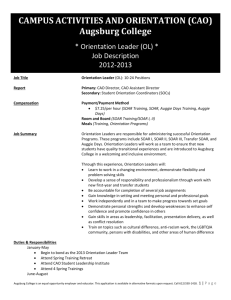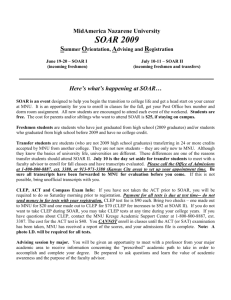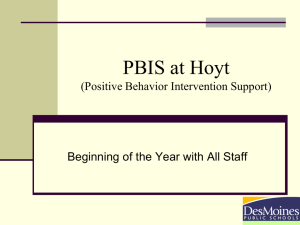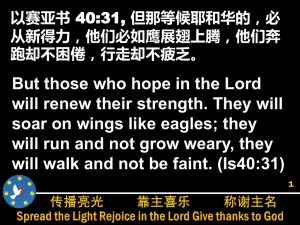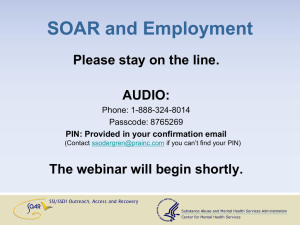AAEA Fall Conference SOAR Presentation
advertisement
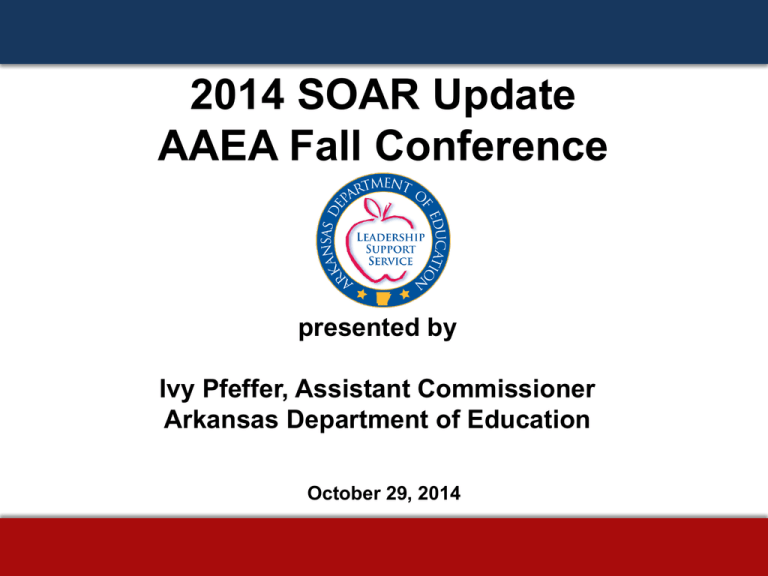
2014 SOAR Update AAEA Fall Conference presented by Ivy Pfeffer, Assistant Commissioner Arkansas Department of Education October 29, 2014 Evaluation- it’s more than simply assigning a label to an educator. It is about gathering data, supporting educators to make meaning of data, and empowering them to use the data to make good decisions for the benefit of their students. TESS Statute • (5) Recognize that evidence of student growth is a significant part of the Teacher Excellence and Support System; • (7) Require annual evidence of student growth from artifacts and external assessment measures; ESEA Flexibility • One-year extension for flexibility from certain provisions of ESEA. The extension is through the 2014-2015 school year. • Principle 3 (teacher and leader evaluation systems) has never been approved – U.S. Department of Education’s continued flexibility is subject to Arkansas’ continuing work with local schools and districts to continue their efforts to ensure that LEAs implement teacher and principal evaluation and support systems that will meet the ESEA flexibility requirements. • In Arkansas’ plan for ESEA flexibility, the state committed to implement teacher and principal evaluation and support systems that used multiple measures in evaluating performance, including student growth based on state assessments as significant factor in evaluating educator effectiveness. • The initial timeline for the implementation 201415 school year. Arkansas requested and received flexibility to extend the timeline for inclusion of student growth in the overall rating. • The U.S. Department of Education has now decided to grant additional flexibility on the implementation timelines for the inclusion of student growth in an educator’s rating under the following conditions: 1. The state agency will calculate student growth data based on state assessments during the transition year for all teachers of tested grades and subjects 2. Each teacher of a tested grade and subject and all principals will receive their student growth data based on State assessments for the 2014-15 school year Options • Options for additional flexibility for Arkansas’ teacher and principal evaluation systems will be considered when states are allowed to submit requests for renewal of ESEA flexibility beyond the 2014-15 school year. • Arkansas will seek options for additional flexibility after receiving guidance regarding the renewal process in the fall of 2014. How Ratings Are Determined Professional Practice Student Performance Performance Rating: Observations; Artifacts/Evidence; Professional Growth Plan Student Growth: Overall Rating Must meet threshold Growth is not a % of the overall rating but acts as a trigger to alter the rating if there is a discrepancy between the performance of 8 the teacher and performance of students. Determining the Threshold Student Ordinal Assessment Rank SOAR Academic Peers • A SOAR Value measures student progress by comparing one student’s progress to the progress of other students with the same performance histories. We refer to these students as “academic peers.” SOAR • SOAR values are a measure of educational progress independent of students’ proficiency levels. SOAR is calculated using Student Percentile Ranks. • All students, no matter the scores they earned on past state tests, have an equal chance to demonstrate growth at any of the SOAR percentile values on the next year’s test. • Even though a student may not achieve a score of 278 out of 280 this year, it is possible for a student to have grown at the 99th percentile from last year to this year. • Although a student may perform well below the proficiency mark, that student could potentially have a high growth percentile. 350 300 Advanced 250 Proficient 200 Basic Albert Maria 150 Jake 100 50 0 Grade 3 Grade 4 Grade 5 Let’s see how Albert’s progress compares to his Academic Peers A comparison to his academic peers allows us to see that Albert actually performed as well as, or outperformed 70% of students who last year scored at the same level. Albert’s SOAR is 70. Teacher SOAR • Teachers’ median SOAR values are included in the evaluation as a companion to teachers’ performance ratings on the Danielson Framework. The expectation is for teachers to meet or exceed the established growth threshold. • Teachers whose SOAR value does not meet the threshold cannot receive an overall rating of “distinguished.” Teachers whose SOAR values don’t meet the threshold for two consecutive years will have their overall rating lowered a level. • If a teacher’s SOAR value and the teacher’s performance rating do not support similar findings about a teacher’s effectiveness, then additional measures and artifacts may be helpful to the teacher and evaluator to further examine the discrepancy. Grade Level SOAR Comparison School Comparison within District-4th Grade Literacy 80 70 SOAR Values 60 50 40 30 20 10 0 Series1 Grade 4 Lit Grade 4 Lit Grade 4 Lit Grade 4 Lit Grade 4 Lit School A School B School C School D School E 29 63 73 41.5 75.5 Depicted in this chart are the median SOAR values for 4th grade literacy in four different schools within a school district. What Does SOAR really Do? • SOAR provides us with data to: –Ask the right Questions –Seek answers to benefit our students. • As more data regarding SOAR is available, the ADE will provide additional information to schools and districts. The ADE is working to develop a training guide for districts to use to help educators better understand SOAR values, the calculation process, and the impact on educator ratings. What’s Next? • Examine course codes for data and school’s coding methods • Look at N’s for special education course codes. • Look at classification consistency (above/below 30) from one year to the next. • Look at stability of teacher median’s from year to year. – One year median SOAR value – Multiple year median SOAR value • What other questions/concerns would additional analyses help to inform? • Other options for growth measures at a local level



